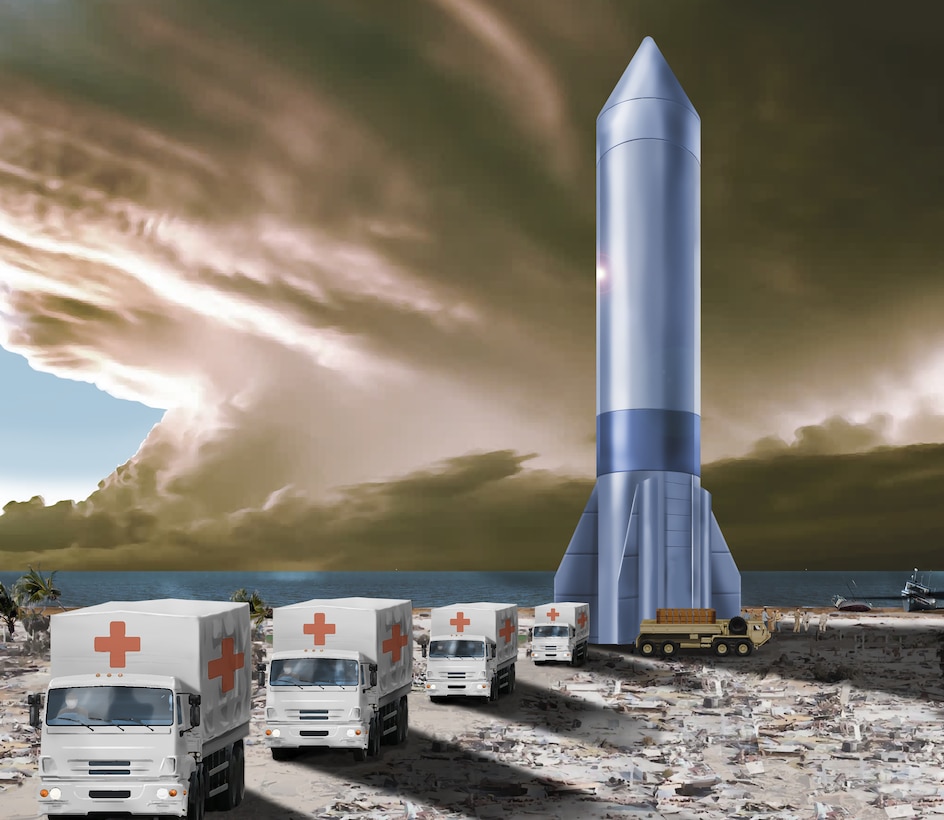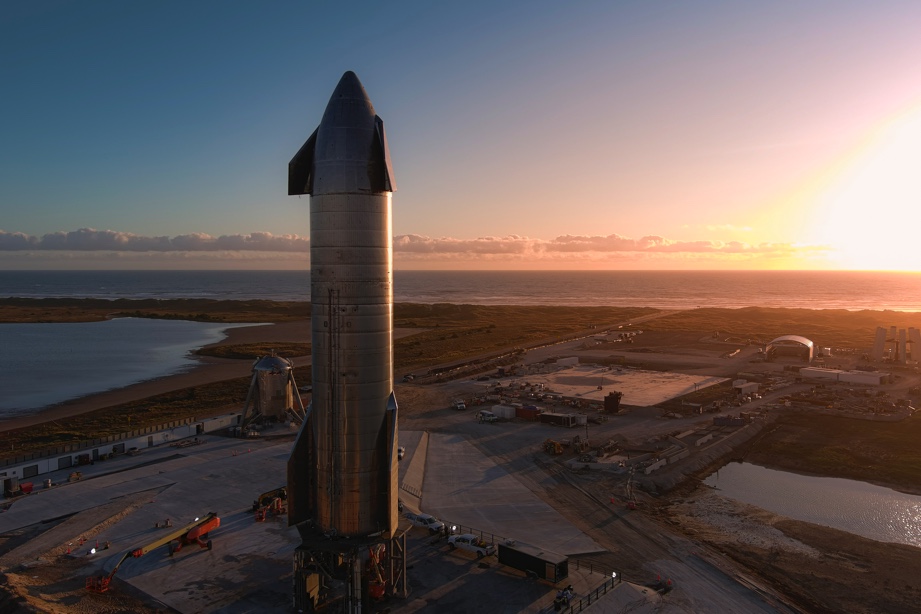
The U.S. military plans to spend nearly $48 million next year on a program that could eventually allow shipment of heavy cargo around the world in less than an hour using giant commercial rockets, such as SpaceX’s Starship vehicle, officials said Friday.
The “Rocket Cargo” program is a joint effort by the U.S. Space Force and U.S. Air Force. The Biden administration has requested $47.9 million for the program in fiscal year 2022, and officials said Friday the Pentagon plans to use the money to examine how gigantic commercial rockets could rapidly deploy military equipment around the world.
“Rocket Cargo is envisioned as a DOD interface with commercial capabilities where we deliver up to 100 tons of cargo anywhere on the planet on tactical timelines,” said Maj. Gen. Heather Pringle, commander of the Air Force Research Laboratory.
The Air Force Research Laboratory is managing the science and technology effort to determine how large commercial rockets could give a boost to the military’s global logistics pipeline. The Space Force is looking studying how to transition the Rocket Cargo transport program to assist military commands, but officials did not provide a timetable for when such a capability might be demonstrated or operational.
“Rapid logistics underpins our ability to project power,” said Gen. Arnold Bunch, Jr., commander of Air Force Materiel Command. “That is the fundamental motivation for initiating the Rocket Cargo program.
“We see its initial applications in swiftly restoring operational capability for forces forward in austere environments as well as dramatically reducing the time required to deliver crucial humanitarian assistance and disaster relief,” Bunch said in an Air Force press release.
In a press briefing Friday, military officials said they want to use new heavy-lift commercial space transportation capabilities originally designed for space exploration for point-to-point cargo deliveries on Earth.
“This idea is been around since the dawn of spaceflight,” said Greg Spanjers, program manager for the Rocket Cargo initiative and chief scientist for the Air Force Strategic Development Planning and Experimentation Directorate. “It’s always been an interesting, intriguing idea.”
But transporting military cargo by rocket “never really made sense in the past,” Spanjers told reporters Friday.
“What has frankly changed is a major emergence on the commercial side, with much higher capability rockets at a much lower cost point that we’re used to seeing,” he said.
Spanjers said the Pentagon will release a solicitation “in the very near future” for companies to propose how their rockets could haul military cargo from one part of Earth to another. The Rocket Cargo program aims to use technology already being developed by private industry, instead launching a more costly, and potentially duplicative, government-led effort, officials said.
The military will assess the affordability of the Rocket Cargo concepts proposed by private industry, and examine what adaptations might be required to tailor the commercial rockets for point-to-point cargo shipments. If the capabilities still look promising, the military could eventually procure cargo transport missions through service leases, but a solicitation for an operational Rocket Cargo capability is likely years away.
“What we recognize is multiple commercial companies are talking about doing demonstrations of their rocket development in the next couple of years,” he said. “If they wish to propose back to us that we could partner up and leverage those flight opportunities to do demonstrations or tests of our own at a greatly reduced costs, we want to make sure the door is open to allow those proposals.
“No specific demonstrations are currently planned,” Spanjers said. “But we certainly do envision doing some during the course of the program.”
Reusable rockets have reduced down the cost of launches, and commercial development of super-heavy-lift launch vehicles has progressed enough to capture the military’s interest.
“The reason we’re doing it now is it looks like technology may have caught up to the good idea,” Spanjers said.
Eventually, commanders could use powerful rockets to deliver up to 100 tons of cargo — more than the weight of an M1 Abrams battle tank — to unprepared landing sites near far-flung military outposts. That would exceed the payload capacity of an Air Force C-17 cargo plane, and a rocket could do the job in a fraction of the time.
“Fundamentally, a rocket can get all the way around the planet in 90 minutes, and an airplane cannot,” Spanjers said.
“If you have a very, very large rocket, the amount of mission you can transport on one flight becomes far more attractive,” he said. “So the fact that we’re looking at rockets with 30- to 100-ton potential capacity — note that 100 tons is about the size of a C-17 load-out. So that’s when it starts getting very interesting to the DOD.”
SpaceX won a NASA contract in April to use its Starship rocket to land humans on the moon. Other companies are developing robotic cargo landers and human-rated ships to fly to the moon later this decade.
“That means these rockets have to have a capability to do an austere landing and offload cargo,” Spanjers said. “If they can land in those places, we’re interested to what extent we can extend that to a larger range of terrains so that we can do immediate cargo transports to basically anywhere on the planet quickly.”

An AFRL spokesperson said the Rocket Cargo program is not considering the use of orbital logistics depots because they come with limitations on delivery locations and timing.
“Inclination changes in space are expensive,” the spokesperson said. “A space depot would add unneeded cost and complexity. It is lower cost, less risk, and faster to simply ship directly from a CONUS (continental United States) location to the delivery site.”
A first Rocket Cargo demonstration might use a large commercial rocket for cargo transport between two established ports, according to Spanjers. An early emphasis of the program will be to look at how to quickly load and unload cargo from rockets before launch and after landing.
The Air Force and Space Force will also study air drops from rockets to deliver cargo areas where the vehicle can’t safely land.
“If the commercial side indeed builds the ability to do point-to-point cargo transport on the planet, we want to be one of the first users and early adopters of this capability,” Spanjers said. “But that means we have to take the containerization and the way we ship our cargo today that’s set up for ship, rail and air transport to make it also compatible with rocket transport.”
Rocket Cargo will become one of the Air Force’s “Vanguard” programs, in which the military invests in emerging technology to help make “game changing” concepts a reality, giving U.S. troops an edge on the battlefield.
The pace of space technology development makes this the right time to invest in rocket transport concepts, said Brig. Gen. Jason Cothern, vice commander of the Space Force’s Space and Missile Systems Center.
“If this technology demonstration proves successful and shows that terrestrial rocket-based cargo transportation is viable and affordable and advantageous to our DOD logistics train, SMC will be responsible for transitioning this Vanguard to a Space Force program of record,” Cothern said.
“We are in a different place technology and commercial investment-wise, in a better place for this particular mission set, than we ever have been,” Cothern said.
SpaceX, led by billionaire Elon Musk, says its next-generation Starship rocket, primarily designed for crew and cargo transportation in deep space, could also ferry people and equipment on super-fast intercontinental flights around Earth.
The Starship, which has not yet flown in space, is designed to be fully reusable, and will be able to carry more than 100 metric tons of payload into low Earth orbit, more than any other rocket in the world.
During an orbital launch attempt, a reusable Super Heavy first stage booster will detach from the Starship, which fills the role of an upper stage, and come back to Earth for a vertical landing. Eventually, SpaceX wants to use catcher arms on the launch tower to capture the descending first stage, making it easier to quickly configure and refuel for another mission.
The Starship will continue into orbit and deploy its payloads or travel to its deep space destination, and finally return to Earth to be flown again.
Using a different flight profile, a rocket like the Starship could launch into space on an arcing, ballistic trajectory before re-entering the atmosphere to land at a location on the other side of the world.
But it’s not just SpaceX, according to Spanjers.
Last year, the Pentagon signed research and development agreements with SpaceX and Exploration Architecture Corporation to evaluate ideas for how to quickly move cargo around the planet using rockets. Spanjers said the new Rocket Cargo program is separate from those agreements.
“We have multiple companies that are using their own money to develop various aspects of re-entry systems that allow you to get the global reach to return the payload anywhere on the planet,” he said. “This is a bill we don’t have to pay, we just need to learn how to leverage it.”
The companies that SpaceX beat to win NASA’s first human-rated lander contract may also have something to offer, Spanjers said.
NASA considered lunar lander proposals submitted by an industry team led by Blue Origin, Jeff Bezos’s space company, with participation from Lockheed Martin, Northrop Grumman, and Draper. Dynetics led another proposal that included contributions from Maxar, Sierra Nevada Corp., United Launch Alliance, and other companies.
“We don’t see SpaceX as being the only viable provider of this capability,” Spanjers said.
Email the author.
Follow Stephen Clark on Twitter: @StephenClark1.
